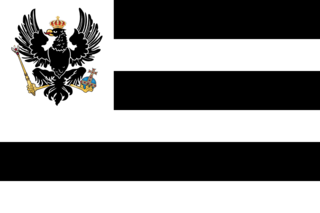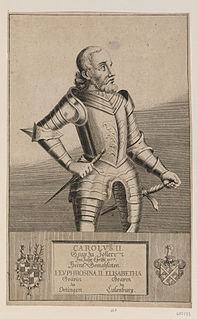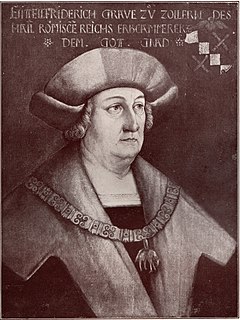
The House of Hohenzollern is a German royal dynasty whose members were variously princes, electors, kings and emperors of Hohenzollern, Brandenburg, Prussia, the German Empire (respectively), and Romania. The family came from the area around the town of Hechingen in Swabia during the late 11th century and took their name from Hohenzollern Castle. The first ancestors of the Hohenzollerns were mentioned in 1061.

Hohenzollern-Sigmaringen was a principality in Southwestern Germany. Its rulers belonged to the senior Swabian branch of the House of Hohenzollern. The Swabian Hohenzollerns were elevated to princes in 1623. The small sovereign state with the capital city of Sigmaringen was annexed to the Kingdom of Prussia in 1850 following the abdication of its sovereign in the wake of the revolutions of 1848, then became part of the newly created Province of Hohenzollern.

Leiningen is the name of an old German noble family whose lands lay principally in Alsace, Lorraine and the Palatinate. Various branches of this family developed over the centuries and ruled counties with Imperial immediacy.
Friedrich I of Nuremberg, the first Burgrave of Nuremberg from the House of Hohenzollern. He was the younger son of Count Friedrich II of Zollern, and became Count of Zollern as Friedrich III after the death of his other male relatives.

Haigerloch is a town in the north-western part of the Swabian Alb in Germany.

Charles II, Count of Hohenzollern-Sigmaringen(German: Karl II, Graf von Hohenzollern-Sigmaringen) became Count of Hohenzollern-Sigmaringen in 1576 and remained so until his death. He was the fifth but second surviving son of Charles I, Count of Hohenzollern, and Anna, daughter of Ernest, Margrave of Baden-Durlach.

Burkhard I, Lord of the House of Hohenzollern is considered the first well-documented ancestor of the Hohenzollern dynasty. Because of his name, it has been attempted to link the Hohenzollern family's descent to the medieval Burchardings family, but without success. His father may have been Friedrich, a count in the Sülichgau area. His mother may have been Irmentrud, the daughter of Count Burkhard of Nellenburg.

Frederick I, Count of Zollern, was often cited as a powerful Swabian Count and supporter of the imperial party of Henry V, Holy Roman Emperor.
Count Friedrich IV of Zollern, also known as Burgrave Friedrich II of Nuremberg, was Burgrave of Nuremberg from 1204 to 1218 and Count of Zollern from 1218 until his death.
Johann Georg of Hohenzollern-Hechingen was the first Prince of Hohenzollern-Hechingen.

Count Eitel Friedrich IV of Hohenzollern was the founder and first Count of the line Hohenzollern-Hechingen as Eitel Friedrich I.
Friedrich V of Zollern nicknamed, the Illustrious was a Count of Zollern.
Friedrich VI, Count of Zollern, also known as Friedrich the Knight, or Friedrich the Elder, was a Count of Hohenzollern

Eitel Friedrich II, Count of Hohenzollern was a count of Hohenzollern and belonged to the Swabian line of the House of Hohenzollern. He was the first president of the Reichskammergericht. As a close friend of the Archduke and later Emperor Maximilian I, he gained great influence in the imperial politics. He managed to consolidate and expand his own territory.
Meinrad II Charles Anthony of Hohenzollern-Sigmaringen was Prince of Hohenzollern-Sigmaringen from 1689 until his death.
Friedrich VII, Count of Zollern was a German nobleman. He was the ruling Count of Zollern from 1298 until his death.
Friedrich IX, Count of Hohenzollern, nicknamed "Fredrick the Old" or "the Black Count", was a German nobleman. He was the ruling count of Hohenzollern from 1339 until his death.
Friedrich X, Count of Hohenzollern, nicknamed Friedrich the Younger or the Black Count was a German nobleman. He was a ruling Count of Hohenzollern.
Friedrich XI, Count of Hohenzollern, nicknamed Friedrich the Elder was a German nobleman. He was a member of the House of Hohenzollern and a ruling Count of Hohenzollern-Hechingen.
Albrecht II of Hohenberg-Rotenburg was Count of Hohenberg and Haigerloch and imperial governor of Lower Swabia. He was a member of the house of Zollern-Hohenberg, a branch of the Swabian House of Hohenzollern which split off in the 12th century. Two stanzas in the Codex Manesse are attributed to him under the name of Albrecht von Haigerloch.








